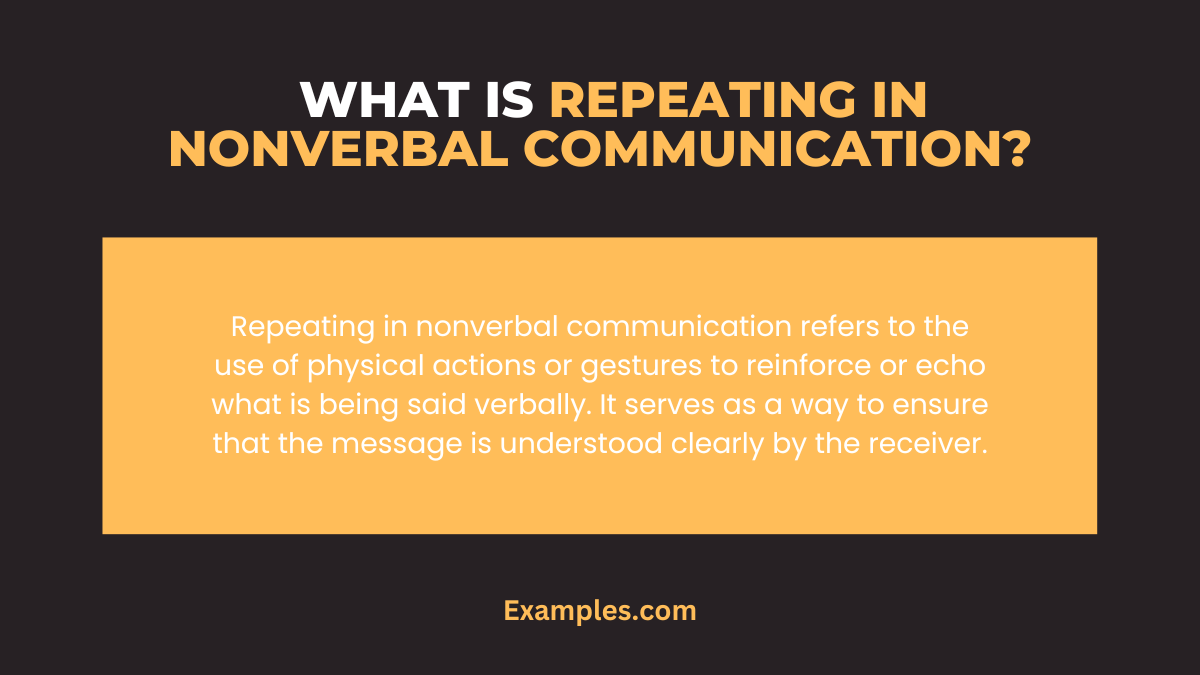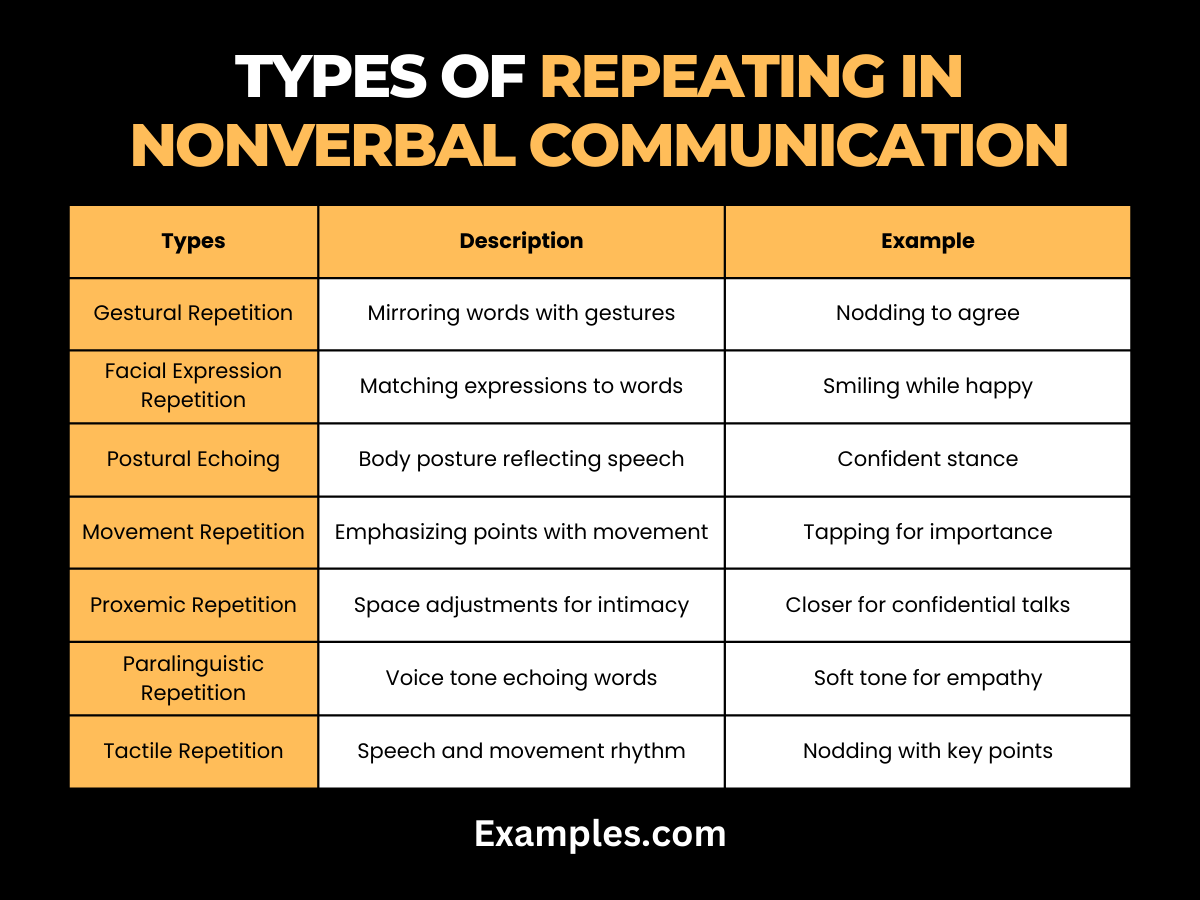Repeating in Nonverbal Communication
Repeating in nonverbal communication is a strategic tool where body language, gestures, and facial expressions are used to echo and reinforce spoken words. This aspect of communication plays a vital role in ensuring that messages are conveyed clearly and effectively. It bridges gaps in verbal communication, ensuring that the intended message is understood and retained. This guide delves into the nuances of repeating in nonverbal cues, highlighting its significance in enhancing everyday communication and interactions.
What is Repeating in Nonverbal Communication?

Repeating in nonverbal communication refers to the use of physical actions or gestures to reinforce or echo what is being said verbally. It serves as a way to ensure that the message is understood clearly by the receiver. This aspect of nonverbal communication is particularly effective in strengthening the delivery of verbal content, ensuring that the key points are communicated effectively and retained by the audience.
Types of Repeating in Nonverbal Communication

The following table outlines various types of repeating in nonverbal communication, each serving to reinforce verbal messages:
| Type | Description | Example |
|---|---|---|
| Gestural Repetition | Using gestures that mimic or mirror the words spoken. | Nodding while saying “yes” to reinforce agreement. |
| Facial Expression Repetition | Facial expressions that reflect the verbal message. | Smiling when talking about a happy event to enhance the positive message. |
| Postural Echoing | Body postures that repeat the tone or content of the verbal message. | Standing with hands on hips to reinforce a statement of confidence or authority. |
| Movement Repetition | Repeating a movement to emphasize a verbal point. | Tapping the table repeatedly to underscore the importance of a statement. |
| Proxemic Repetition | Adjusting physical space to mirror verbal intimacy or distance. | Moving closer while expressing personal or confidential information. |
| Paralinguistic Repetition | Using vocal elements like tone, pitch, and pauses to mimic verbal content. | Changing tone to a softer pitch when expressing sympathy or empathy. |
| Tactile Repetition | Using touch to emphasize verbal communication. | A reassuring hand on the shoulder while offering comforting words. |
| Rhythmic Repetition | Aligning speech rhythm with body movements for emphasis. | Nodding or hand gesturing in rhythm with key points in a speech. |
Understanding and effectively utilizing these types of repeating in nonverbal communication can greatly enhance the clarity and impact of verbal interactions in various contexts, from everyday conversations to formal presentations and speeches.
What are the Ways of Repeating in Nonverbal Communication?
Repeating in nonverbal communication involves various strategies to mirror or reinforce verbal messages. These methods are crucial in ensuring that the intended message is effectively communicated and understood. Here are some key ways in which nonverbal cues can repeat verbal communication:
Mirroring Gestures with Words
- Complementary Hand Gestures: Using hand gestures that align with the spoken words, such as pointing when giving directions.
- Facial Gestures: Facial expressions that match the emotional tone of the spoken words, like frowning when expressing concern.
Echoing Through Body Language
- Posture Alignment: Adopting a body posture that reflects the sentiment of the verbal message, such as leaning forward to show interest or concern.
- Physical Actions: Actions like nodding or shaking the head in agreement or disagreement with what is being said.

Vocal Emphasis
- Tone and Pitch Repetition: Modulating the tone, pitch, and volume of the voice to match the verbal message, like raising the voice for excitement.
- Rhythmic Speech Patterns: Aligning speech rhythm with gestures or body movements for emphasis.
Proxemics and Spatial Relationships
- Adjusting Physical Distance: Modifying the physical space between communicators to mirror the intimacy or formality of the verbal message.
- Positioning in Group Settings: Strategic positioning in group interactions to reflect alignment or disagreement with the spoken content.

Tactile Reinforcement
- Use of Touch: Employing touch, such as a pat on the back or a handshake, to reinforce verbal messages of agreement, support, or congratulations.
Consistency in Paralinguistics
- Aligning Speech Characteristics: Ensuring that speech characteristics like pace and pauses align with the verbal message, using pauses for emphasis or speeding up for urgency.
Synchronization with Movement
- Movement Synchronization: Coordinating movements like hand gestures or head nods with key points in the verbal message to underscore their importance.
What is the Importance of Repeating in Nonverbal Communication?
Repeating in nonverbal communication is vital for reinforcing and clarifying verbal messages, ensuring they are correctly understood and remembered. Its significance lies in several key aspects:
Enhancing Message Clarity
- Eliminating Ambiguities: By mirroring verbal statements with nonverbal cues, repeating reduces misunderstandings and ambiguities in communication.
- Clarifying Intent: It helps in making the intent behind the words clear, particularly in complex or nuanced conversations.
Strengthening Message Impact
- Emphasizing Key Points: Nonverbal repetition is instrumental in emphasizing the most important parts of a message, ensuring they stand out.
- Improving Retention: Messages accompanied by consistent nonverbal cues are more likely to be remembered by the audience.
Aiding in Effective Communication Across Cultures
- Cross-Cultural Understanding: In multicultural interactions, repeating through universally understood nonverbal cues can bridge language barriers.
- Adapting to Communication Styles: It allows for the adaptation of communication styles to suit diverse cultural norms and expectations.
Tips for Repeating in Nonverbal Communication
To effectively incorporate repeating in nonverbal communication, consider these tips:
Align Nonverbal Cues with Verbal Messages
- Consistent Gestures: Ensure your gestures and expressions align with and accurately reflect the verbal message.
- Appropriate Facial Expressions: Use facial expressions that match the emotional tone of your words.
Practice and Observe
- Self-Awareness: Regularly reflect on and practice your nonverbal communication skills.
- Observation: Learn from observing others, particularly skilled communicators, and their use of nonverbal repetition.
Understand Cultural Variations
- Cultural Sensitivity: Be aware of different nonverbal communication interpretations in various cultures.
- Adaptation: Adjust your nonverbal cues to suit the cultural context of your audience.
Enhance Vocal Elements
- Vocal Emphasis: Use variations in tone, pitch, and pace to reinforce your verbal messages.
- Rhythmic Speech: Align your speech rhythm with nonverbal actions for emphasis.
Utilize Effective Body Language
- Purposeful Gestures: Use gestures deliberately to underscore important parts of your message.
- Posture and Movement: Adopt postures and movements that reflect and repeat the message’s tone.
In summarizing the importance of repeating in nonverbal communication, it’s clear that these nonverbal echoes are key to reinforcing and solidifying the spoken message. The ability to effectively repeat verbal communication through nonverbal cues like gestures, facial expressions, and body language not only enhances understanding but also ensures that the message is remembered. Mastering this aspect of communication is essential in both personal and professional settings, where clear and effective message delivery can significantly impact interactions and outcomes.
For further exploration into the intricacies of nonverbal communication, resources provided by the University of California, Los Angeles (UCLA) – Communication Studies can be invaluable. Additionally, the National Communication Association offers a wealth of information and research on various aspects of communication, including nonverbal aspects. These resources can provide deeper insights and practical strategies to enhance your nonverbal communication skills.



